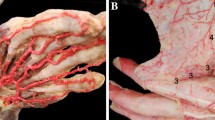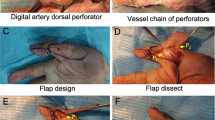Abstract
Background
Many approaches have been reported to repair soft-tissue defects of the hand using dorsal metacarpal artery flaps. Use of a perforator-based propeller flap from the first intermetacarpal space to the dorsum of the hand has been described. The aim of this study was to confirm the functional anatomy of a first dorsal metacarpal artery (FDMA) perforator flap.
Methods
Twenty-nine fixed cadaveric hands were dissected to determine the origin, course, and branches of the FDMA. Clinically, five cases of soft tissue defects of the hand underwent reconstructive surgery using an FDMA perforator-based propeller flap.
Results
The FDMA was found in 27 specimens (93%). The ulnar branch of the FDMA always supplied the cutaneous perforator (mean ± SD, 4.3 ± 1.6), and the most distal cutaneous perforating branch was found along the metacarpal long axis within 25 mm of the tip of the metacarpal head with high frequency (28/29, 97%). In the two hands that had aplasia of the FDMA, well-developed perforators arose directly from the radial artery and advanced to the metacarpal head. Seven hands (24%) had perforators arising from the palmar arterial system, penetrating through or passing close by the second metacarpal bone. In clinical application, all the flaps survived completely without major complications.
Conclusions
The FDMA perforator-based propeller flap is minimally invasive and technically simple. It is expected to be a new option for hand reconstruction.






Similar content being viewed by others
Data availability
Not applicable.
Code availability
Not applicable.
References
Checcucci G, Galeano M, Zucchini M, Zampetti PG, Ceruso M (2014) Reverse flow first dorsal metacarpal artery flap for covering the defect of distal thumb. Microsurgery 34:283–286
Dautel G, Borrelly J, Merle M, Michon J (1989) Dorsal vascular network of the first web space. Anatomical bases of the kite flap. Surg Radiol Anat 11:109–113
di Summa PG, Davies K, Hart A (2020) The first dorsal metacarpal propeller perforator (FDMP) flap for finger reconstruction. Case Rep Plastic Surg Hand Surg 7:94–97
Earley MJ, Milner RH (1987) Dorsal metacarpal flaps. Br J Plast Surg 40:333–341
Foucher G, Braun JB (1979) A new island flap transfer from the dorsum of the index to the thumb. Plast Reconstr Surg 63:344–349
Friedrich JB, Katolik LI, Vedder NB (2009) Soft tissue reconstruction of the hand. J Hand Surg Am 34:1148–1155
Holevich J (1963) A new method of restoring sensibility to the thumb. J Bone Joint Surg Br 45:496–502
Hu D, Wei Z, Wang T, Hong X, Zheng H, Lin J (2020) Anatomical basis and clinical application of the dorsal perforator flap based on the palmar artery in the first web. Surg Radiol Anat 42:269–276
Ikeda A, Ugawa A, Kazihara Y, Hamada N (1988) Arterial patterns in the hand based on a three-dimensional analysis of 220 cadaver hands. J Hand Surg Am 13:501–509
Luan Z, Liu B, Jiang H, Gao F, Yang B (2019) Reverse first dorsal metacarpal artery flap repair of a right thumb epidermis granuloma: a case study. Oncol Lett 18:2384–2387
Maruyama Y (1990) The reverse dorsal metacarpal flap. Br J Plast Surg 43:24–27
Miller EA, Friedrich J (2016) Soft tissue coverage of the hand and upper extremity: the reconstructive elevator. J Hand Surg Am 41:782–792
Murakami T, Takaya K, Outi H (1969) The origin, course and distribution of arteries to the thumb, with special reference to the so-called A. princeps pollicis. Okajimas Folia Anat Jpn 46:123–137
Nanno M, Kodera N, Tomori Y, Hagiwara Y, Takai S (2017) Color Doppler ultrasound assessment for identifying perforator arteries of the second dorsal metacarpal flap. J Orthop Surg (Hong Kong) 25:1–5
Omokawa S, Tanaka Y, Ryu J, Kish VL (2005) The anatomical basis for reverse first to fifth dorsal metacarpal arterial flaps. J Hand Surg Br 30:40–44
Quaba AA, Davison PM (1990) The distally-based dorsal hand flap. Br J Plast Surg 43:28–39
Sebastin SJ, Mendoza RT, Chong AK, Peng YP, Ono S, Chung KC, Lim AY (2011) Application of the dorsal metacarpal artery perforator flap for resurfacing soft-tissue defects proximal to the fingertip. Plast Reconstr Surg 128:166e–178e
Sherif MM (1994) First dorsal metacarpal artery flap in hand reconstruction. I. Anatomical study. J Hand Surg Am 19:26–31
Yannascoli SM, Thibaudeau S, Levin LS (2015) Management of soft tissue defects of the hand. J Hand Surg Am 40:1237–1244
Acknowledgements
We thank Mr. Hiroshi Sasaki at the Department of Anatomy and Neurobiology, National Defense Medical College for preparation of the cadavers and technical assistance.
Funding
No funding was received for this article.
Author information
Authors and Affiliations
Contributions
TA: Project development, Data collection, Data analysis, Manuscript writing. TH: Data collection. TK: Project development, Manuscript editing. YK: Technical advice, Manuscript editing.
Corresponding author
Ethics declarations
Conflict of interest
The authors declare that they have no conflict of interests.
Ethics approval
This study was performed in a university with institutional review board approval (No. 4151 and 4307).
Consent to participate/for publication
Written consents were obtained from the donors in advance, and the agreements to the donation and its use were obtained also from the families at donation. For the clinical application, patients give written informed consent according to the principles of the Declaration of Helsinki.
Additional information
Publisher's Note
Springer Nature remains neutral with regard to jurisdictional claims in published maps and institutional affiliations.
Supplementary Information
Below is the link to the electronic supplementary material.
Supplementary file1 Online Resource 1 Dynamic fluorescence angiography of the left hand. Indocyanine green solution is injected into the radial artery. Locations and territories of the perforators can be detected in real time by using infrared CCD camera (Photodynamic Eye, Hamamatsu Photonics K.K., Shizuoka, Japan) (MP4 18919 KB)
Rights and permissions
About this article
Cite this article
Aizawa, T., Hirayama, T., Kiyosawa, T. et al. First dorsal metacarpal artery perforator-based propeller flap: functional anatomy and clinical application in soft-tissue defects of the dorsal hand and digits. Surg Radiol Anat 44, 215–221 (2022). https://doi.org/10.1007/s00276-021-02845-z
Received:
Accepted:
Published:
Issue Date:
DOI: https://doi.org/10.1007/s00276-021-02845-z




